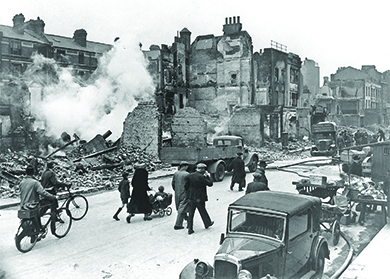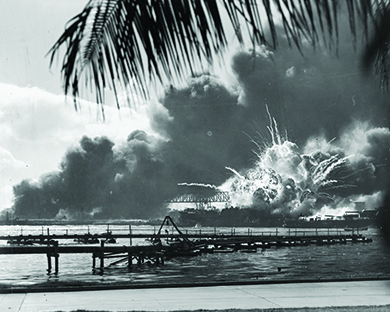| << Chapter < Page | Chapter >> Page > |
Listen to the BBC’s archived reports of the Battle of Britain, including Winston Churchill’s “Finest Hour” speech.
In August 1941, Roosevelt met with the British prime minister, Winston Churchill, off the coast of Newfoundland, Canada. At this meeting, the two leaders drafted the Atlantic Charter, the blueprint of Anglo-American cooperation during World War II. The charter stated that the United States and Britain sought no territory from the conflict. It proclaimed that citizens of all countries should be given the right of self-determination, self-government should be restored in places where it had been eliminated, and trade barriers should be lowered. Further, the charter mandated freedom of the seas, renounced the use of force to settle international disputes, and called for postwar disarmament.

In March 1941, concerns over Britain’s ability to defend itself also influenced Congress to authorize a policy of Lend Lease, a practice by which the United States could sell, lease, or transfer armaments to any nation deemed important to the defense of the United States. Lend Lease effectively ended the policy of nonintervention and dissolved America’s pretense of being a neutral nation. The program ran from 1941 to 1945, and distributed some $45 billion worth of weaponry and supplies to Britain, the Soviet Union, China, and other allies.
By the second half of 1941, Japan was feeling the pressure of the American embargo. As it could no longer buy strategic material from the United States, the Japanese were determined to obtain a sufficient supply of oil by taking control of the Dutch East Indies. However, they realized that such an action might increase the possibility of American intervention, since the Philippines, a U.S. territory, lay on the direct route that oil tankers would have to take to reach Japan from Indonesia. Japanese leaders thus attempted to secure a diplomatic solution by negotiating with the United States while also authorizing the navy to plan for war. The Japanese government also decided that if no peaceful resolution could be reached by the end of November 1941, then the nation would have to go to war against the United States.
The American final counterproposal to various offers by Japan was for the Japanese to completely withdraw, without any conditions, from China and enter into nonaggression pacts with all the Pacific powers. Japan found that proposal unacceptable but delayed its rejection for as long as possible. Then, at 7:48 a.m. on Sunday, December 7, the Japanese attacked the U.S. Pacific fleet at anchor in Pearl Harbor, Hawaii ( [link] ). They launched two waves of attacks from six aircraft carriers that had snuck into the central Pacific without being detected. The attacks brought some 353 fighters, bombers, and torpedo bombers down on the unprepared fleet. The Japanese hit all eight battleships in the harbor and sank four of them. They also damaged several cruisers and destroyers. On the ground, nearly two hundred aircraft were destroyed, and twenty-four hundred servicemen were killed. Another eleven hundred were wounded. Japanese losses were minimal. The strike was part of a more concerted campaign by the Japanese to gain territory. They subsequently attacked Hong Kong, Malaysia, Singapore, Guam, Wake Island, and the Philippines.

Whatever reluctance to engage in conflict the American people had had before December 7, 1941, quickly evaporated. Americans’ incredulity that Japan would take such a radical step quickly turned to a fiery anger, especially as the attack took place while Japanese diplomats in Washington were still negotiating a possible settlement. President Roosevelt, referring to the day of the attack as “a date which will live in infamy,” asked Congress for a declaration of war, which it delivered to Japan on December 8. On December 11, Germany and Italy declared war on the United States in accordance with their alliance with Japan. Against its wishes, the United States had become part of the European conflict.
You can listen to Franklin Roosevelt’s speech to Congress seeking a Declaration of War at this archive of presidential recordings.
America sought, at the end of the First World War, to create new international relationships that would make such wars impossible in the future. But as the Great Depression hit Europe, several new leaders rose to power under the new political ideologies of Fascism and Nazism. Mussolini in Italy and Hitler in Germany were both proponents of Fascism, using dictatorial rule to achieve national unity. Still, the United States remained focused on the economic challenges of its own Great Depression. Hence, there was little interest in getting involved in Europe’s problems or even the China-Japan conflict.
It soon became clear, however, that Germany and Italy’s alliance was putting democratic countries at risk. Roosevelt first sought to support Great Britain and China by providing economic support without intervening directly. However, when Japan, an ally of Germany and Italy, attacked Pearl Harbor, catching the military base unaware and claiming thousands of lives, America’s feelings toward war shifted, and the country was quickly pulled into the global conflict.

Notification Switch
Would you like to follow the 'U.s. history' conversation and receive update notifications?